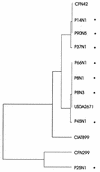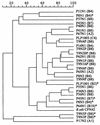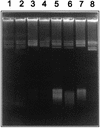Prevalence of the Rhizobium etli-like allele in genes coding for 16S rRNA among the indigenous rhizobial populations found associated with wild beans from the Southern Andes in Argentina
- PMID: 9726909
- PMCID: PMC106759
- DOI: 10.1128/AEM.64.9.3520-3524.1998
Prevalence of the Rhizobium etli-like allele in genes coding for 16S rRNA among the indigenous rhizobial populations found associated with wild beans from the Southern Andes in Argentina
Abstract
A collection of rhizobial isolates from nodules of wild beans, Phaseolus vulgaris var. aborigineus, found growing in virgin lands in 17 geographically separate sites in northwest Argentina was characterized on the basis of host range, growth, hybridization to a nifH probe, analysis of genes coding for 16S rRNA (16S rDNA), DNA fingerprinting, and plasmid profiles. Nodules in field-collected wild bean plants were largely dominated by rhizobia carrying the 16S rDNA allele of Rhizobium etli. A similar prevalence of the R. etli allele was observed among rhizobia trapped from nearby soil. Intragroup diversity of wild bean isolates with either R. etli-like or Rhizobium leguminosarum bv. phaseoli-like alleles was generally found across northwest Argentina. The predominance of the R. etli allele suggests that in this center of origin of P. vulgaris the coevolution of Rhizobium spp. and primitive beans has resulted in this preferential symbiotic association.
Figures



References
-
- Aguilar, O. M., D. H. Grasso, P. M. Riccillo, M. V. López, and E. Szafer. Rapid identification of bean rhizobial isolates type I by a nifH-PCR assay. Soil Biol. Biochem., in press.
-
- Aguilar, O. M., and M. V. López. Unpublished results.
-
- Amarger N, Bours M, Revoy F, Allard M R, Laguerre G. Rhizobium tropici nodulates field-grown Phaseolus vulgaris in France. Plant Soil. 1994;161:147–156.
-
- Beringer J E. R factor transfer in Rhizobium leguminosarum. J Gen Microbiol. 1974;84:188–198. - PubMed
Publication types
MeSH terms
Substances
Associated data
- Actions
- Actions
- Actions
- Actions
- Actions
- Actions
- Actions
- Actions
LinkOut - more resources
Full Text Sources
Miscellaneous

